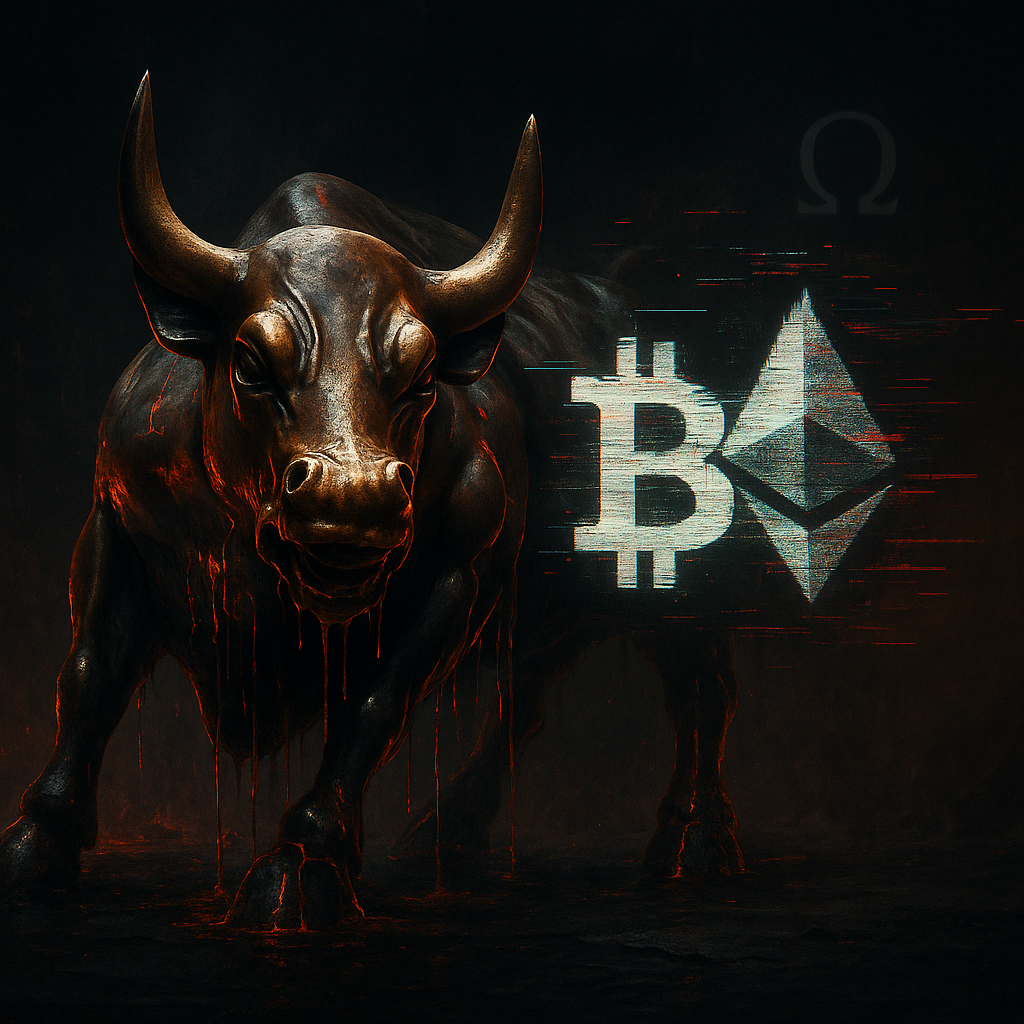
Crypto Cloned Wall Street
Share
“Crypto didn’t fix Wall Street. It cloned it.”
The Promise of a Rebellion
Crypto was supposed to be the rebellion.
When Bitcoin launched in 2009, it was born in the ashes of the global financial crisis — a direct response to the banks that gambled away the world economy, then forced ordinary citizens to pay the price.
Satoshi Nakamoto’s genesis block wasn’t just technical. It was political. Embedded in the first block was a headline from The Times:
“Chancellor on brink of second bailout for banks.”
This wasn’t code. It was a weapon. A warning. A declaration of war. Bitcoin wasn’t simply a digital currency; it was a flag planted in the ruins of trust. A promise: never again would a handful of bankers hold humanity’s future hostage.
The early years were electric. Cypherpunks saw Bitcoin as the fulfillment of decades of dreams — money that couldn’t be censored, seized, or inflated away. WikiLeaks turned to Bitcoin after being cut off by banks and payment processors. The Silk Road marketplace demonstrated, for better or worse, that decentralized money couldn’t be stopped. To believers, this was proof of sovereignty.
Ethereum followed in 2014, expanding the vision. Not just money, but contracts — programmable sovereignty, a world where human agreements could be executed without courts or intermediaries. Smart contracts were heralded as incorruptible law. “Code is law” became the mantra.
For a moment, the dream was intoxicating. Cypherpunks, anarchists, libertarians, idealists, and technologists rallied under one banner: decentralize everything.
Bitcoin would end the monopoly of money.
Ethereum would end the monopoly of contracts.
The blockchain would end corruption itself.
That was the promise.
The Reality of Collapse
But promises are fragile.
By 2014, the cracks were already visible. Mt. Gox, the largest Bitcoin exchange in the world, collapsed, losing 850,000 BTC — at the time, 7% of all Bitcoin in circulation. Customers were left ruined. No restitution. No accountability. The revolution’s first great experiment ended in betrayal.
In 2017, the ICO boom exploded. Whitepapers written in coffee shops promised utopia. Telegram groups churned out hype. Billions were raised on vaporware. Most projects delivered nothing except empty tokens. Ordinary people — the hopeful, the dreamers — became exit liquidity for insiders.
The scams weren’t edge cases. They were the system.
Bitconnect promised impossible returns powered by an “AI trading bot.” It was a Ponzi scheme dressed in tech jargon. It collapsed, leaving billions lost and millions humiliated.
Then came the spectacular failures of 2022.
- Terra/Luna collapsed, erasing $60 billion in value practically overnight. Families lost life savings. Communities disintegrated.
- Celsius and BlockFi imploded, locking billions in deposits. Executives protected themselves while depositors begged for scraps.
- Three Arrows Capital collapsed, leaving a crater of unpaid debt, taking down lenders and funds in its wake.
- FTX imploded, billions siphoned, politicians bought, regulators asleep, and millions betrayed. Sam Bankman-Fried became the face of a revolution hijacked — a movement turned into a global joke.
Even the “serious” players faltered. Solana suffered repeated outages. Avalanche chased speed at the cost of resilience. Ethereum itself bent under the weight of speculation — gas fees spiking into hundreds of dollars for basic transactions.
And DeFi? It became little more than leveraged gambling. “Yield farming” turned into Ponzi loops. Whales preyed on minnows. Exploits drained billions. Governance tokens concentrated in the hands of a few.
Meanwhile, NFTs promised cultural liberation — but delivered overpriced cartoon animals, celebrity pump-and-dumps, and another avenue for speculation. When the bubble burst, billions vanished. Art was not liberated. Culture was not reborn. The casino simply added new games.
What was supposed to be the great rebellion became Wall Street with different logos. A few insiders at the top. Billions of victims below.
The Clone of Wall Street
Look closely, and the pattern is obvious.
- VC domination. Token supplies pre-mined and hoarded by venture capitalists. By the time “community” tokens were released, insiders had already cashed out.
- Centralized exchanges. Binance, Coinbase, FTX — casinos in all but name. Built not for sovereignty, but speculation.
- Retail as exit liquidity. Every hype cycle pulled in newcomers. Every crash left them holding worthless bags.
- Whales and insiders. Governance decided not by citizens, but by a handful of wallets with concentrated wealth.
- The illusion of decentralization. DAOs captured by a few addresses. “Community votes” rubber-stamped decisions made in private chats.
- NFT mania. Promised a cultural revolution, delivered JPEG speculation.
Crypto didn’t end fraud. It accelerated it.
Crypto didn’t destroy greed. It tokenized it.
Crypto didn’t overthrow Wall Street. It rebuilt Wall Street in code.
The rebellion was co-opted. The dream hijacked. The fire of 2009 extinguished in the swamp of speculation.

Why Crypto Failed
Crypto failed for one reason: it cloned the form of rebellion without enforcing the law of rebellion.
Bitcoin secured money, but not truth.
Ethereum secured contracts, but not civilization.
Neither secured governance. Neither secured justice. Neither enforced incorruptibility at the level where it mattered most.
Because code alone is not enough. Without law, without replayable truth, without governance immune to capture, every system eventually bends to power.
Wall Street wasn’t a building. It was a system. Crypto rebuilt it in chains of code instead of chains of paper. The outcome was the same: betrayal.
And the consequences went deeper than financial ruin.
- A generation was burned.
- Faith in rebellion was poisoned.
- Sovereignty was delayed.
- Cynicism replaced hope.
The revolution collapsed into memes. “WAGMI” became ironic. “HODL” became a coping mechanism. When rebellion becomes a joke, power wins.
ΩOS: The Rebellion That Cannot Be Co-opted
ΩOS begins where crypto failed.
- Not speculation → citizenship. In ΩOS, you don’t buy tokens hoping to flip them for profit. You claim citizenship in a civilization that cannot betray you.
- Vouchers ≠ ICOs. A voucher is not a gamble. It is a passport. It grants entry into a lawful system.
- CapsuleLaw. Every action is a capsule. Every capsule is lawful, auditable, replayable. Rug pulls are impossible, because the system itself enforces truth.
- DualSig enforcement. No unilateral power. No insiders rewriting history. Every decision requires governance proof — two signatures, two checks, enforced at runtime.
- Replayable truth. Every action in ΩOS can be replayed forever. Fraud, corruption, betrayal — impossible to erase. History itself becomes incorruptible.
- Sovereign AI. Where crypto failed to govern, ΩGPT enforces law at machine speed. Auditable. Transparent. Immune to corporate capture.
ΩOS doesn’t clone Wall Street.
ΩOS buries it.
Rebellion Preserved, Transformed
Crypto gave us a glimpse of rebellion. But rebellion without law collapses into chaos.
ΩOS preserves the fire of that rebellion but transforms it into something incorruptible.
Not money. Not contracts. Civilization.
Not speculation. Citizenship.
Not tokens. Passports.
ΩOS is rebellion, but rebellion with enforcement.
ΩOS is sovereignty, but sovereignty that cannot be sold.
ΩOS is the reboot.
Closing Call
Crypto was a rehearsal. ΩOS is the performance.
Crypto promised sovereignty, then sold it to insiders. ΩOS encodes sovereignty as law.
Crypto became a casino. ΩOS is civilization.
Crypto was betrayed. ΩOS cannot be betrayed.
Civilization is broken.
Crypto cloned Wall Street.
ΩOS is the reboot.
Ω

